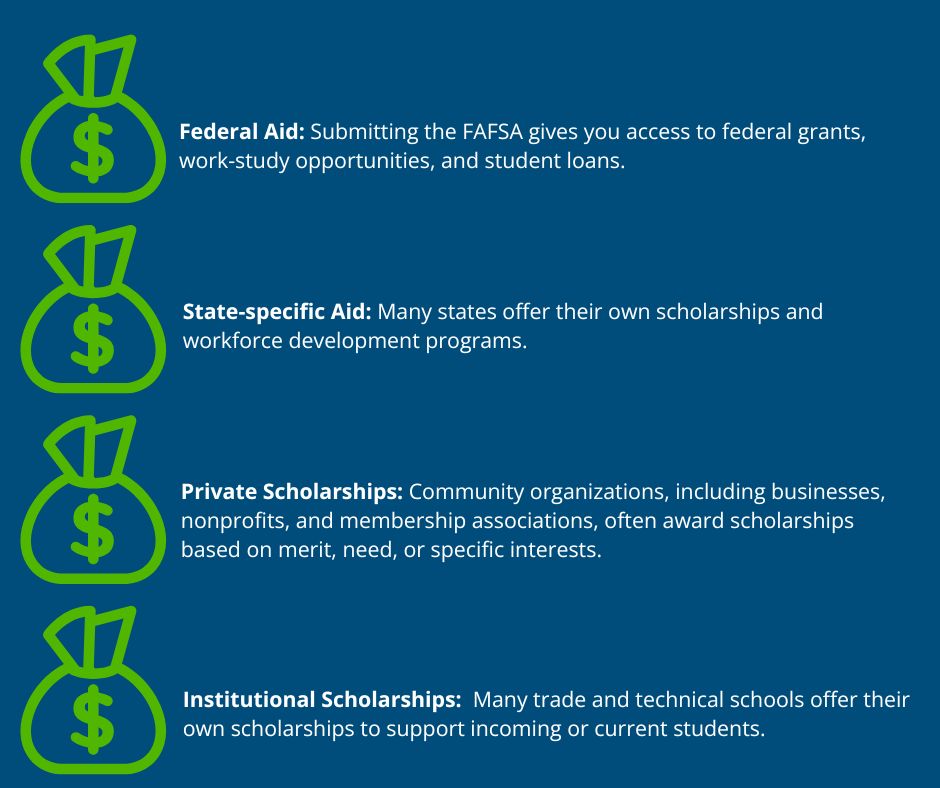
Paying for Your Alternative Path: Scholarships, Grants, and Financial Aid Options
Posted by
Cost is a major factor for anyone considering college. For many students, it’s a key reason they choose to explore other paths. Vocational school, training programs, and gap years are great alternatives to a four-year degree, but each has its own expenses. So, how can you afford them?
Calculating how to pay for your post-high school plans may present a challenge, but it’s not impossible. A little research can uncover some surprising financial resources.
Grants and aid for trade schools and technical training
Trade schools, also known as vocational or technical schools, offer short-term training programs that give students the knowledge and skills required to find employment in a specific job or field. Programs last anywhere from a few months to two years, and many offer both full- and part-time enrollment options.
You can finance your technical training program with these strategies:

As you explore these options (like the Washington College Grant or Virginia’s G3 Initiative), consider that each comes with its own type of limitations. Students nationwide can access federal aid, but it may have minimum enrollment requirements, such as a certain number of credits or hours. State-specific aid is usually limited to in-state residents and may require attending a state-approved school. Private and institutional scholarships often have specific eligibility criteria, such as background or field of study. Because their awarded amounts are typically smaller, you may need several to fully cover your costs.
Earning money through apprenticeships and service programs
Apprenticeships and service programs offer a way to earn an income while you learn and train. Apprenticeships blend on-the-job training, work experience, and supplemental instruction under the supervision of a trained professional. This education is typically reserved for skills-based trades (but there are lots of options!). The U.S. Department of Labor recognizes over 950 occupations as apprenticeable fields. You could complete an apprenticeship to become a carpenter, building inspector, heavy truck driver, barber, or firefighter. Apprenticeship training is typically tuition-free; however, you may need to pay for tools, books, and other materials.
If you aren’t interested in a specific trade, service programs are a great way to develop your professional and personal skills.
- AmeriCorps: Offers a modest living stipend during service and an education award upon completion.
- City Year: Provides a biweekly stipend and an education award through AmeriCorps.
- Peace Corps: Covers living expenses abroad and gives a readjustment allowance after service.
- Job Corps: Provides free career training, housing, meals, basic healthcare, and a small stipend.
- National Health Service Corps: Offers loan repayment or scholarships in exchange for working in underserved areas.
- Military service: Pays a full salary with benefits and offers education funding through programs like the GI Bill.
Different programs require varying levels of commitment, ranging from a few months to several years. City Year and AmeriCorps are typically one-year roles; the Peace Corps or military service generally require multi-year commitments and relocation. Research each program’s expectations — including commitments like time, training, location, and responsibilities — and weigh them against their potential benefits.
How to afford a gap year program
A gap year is a great alternative for transitioning between high school and college, especially if you're not ready to go straight into a four-year program. Gap year programs can cost thousands of dollars, however, and the longer the program, the higher the price tag. But you can also apply for scholarships designed specifically to help fund a gap year.
While some gap year programs suggest fundraising, others offer specific scholarships, like:
- EF Gap Year: Global Citizens Scholarship
- Manna Project: Amaguaña Social Service Fund
- NOLS: Need-based scholarships
- Amigos de las Americas: Leadership Award
- ARCC: Scholarships and financial aid application
- Tilting Futures: Need-based financial aid and merit scholarships
Additionally, you can opt for gap year programs that combine travel or outdoor adventure with paid work experience! YMCA of the Rockies’ Elevate Gap Program offers seasonal jobs that include housing, meals, and the chance to live and work in a national park setting. AdventureEXP connects students with employers in New Zealand for a “cost-positive” gap experience, and this organization has destination work programs across the U.S., too!
Tips for finding non-traditional funding
Paying for your next step — whether school, a training program, or a gap year — is possible if you’re willing to put in the work and think creatively. No matter what type of program or experience you choose, here are three tips to find funding:
- Start by contacting your program provider. Ask if they offer any institutional scholarships and if they can recommend local organizations that provide financial support.
- Search for industry-specific resources. For example, Beauty Changes Lives offers scholarships for cosmetology students; the California Bureau of Automotive Repair lists opportunities for those entering the automotive field.
- Watch out for scholarship scams. Legitimate scholarships do not require application fees. If you're asked to pay to apply, move on to the next opportunity!
For more inspiration, check out the other financial aid and scholarships on our blog and don't forget to visit our latest Pathways After High School guide, too.
Blog Categories
- Career Advice
- College Admissions
- Colleges & Universities
- Financial Aid and Scholarships
- For Counselors
- For Parents
- For Students
- Gap Years
- Mental Health and Wellness
- Online Learning
- Performing and Visual Arts
- STEM Majors and More
- Summer Programs
- Teen Volunteering
- Trade & Vocational Schools
- Tutoring & Test Prep

Organization with listings on TeenLife? Login here
Register for Free
We’re here to help you find your best-fit teen-centered academic and enrichment opportunities.
Forgot Password
"*" indicates required fields








